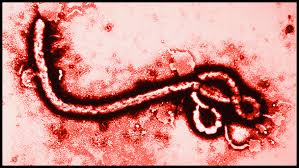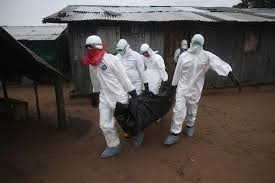US Defense Department Weaponized Ebola?
By T.J. Coles
24 August, 2014.
By 22 August 2014, 1,427 individuals in Guinea, Liberia, Nigeria, and Sierra Leone had died from Ebola, a disease that causes internal haemorrhaging and organ failure.1
A Stanford University study notes that Ebola was discovered in 1976 and named after the Ebola River in Zaire (now Congo). ‘The first outbreak of Ebola (Ebola-Sudan) infected over 284 people, with a mortality rate of 53%. A few months later, the second Ebola virus emerged from Yambuku, Zaire, Ebola-Zaire (EBOZ). EBOZ, with the highest mortality rate of any of the Ebola viruses (88%), infected 318 people’.2
If the US Defense Department did not create Ebola, it almost certainly developed a biological weapon with it.
In 1956,the US Army Medical Unit was established in Fort Detrick, Maryland. In 1969, the unit was replaced by the US Army Medical Research Institute of Infectious Diseases (USAMRIID). The main lab for USAMRIID was completed in 1971. From 1977 to 1983, Colonel Richard F. Barquist led USAMRIID research into Argentine hemorrhagic fever, Rift Valley fever, and other haemorrhagic fevers, the Fort Detrick website explains. It goes on:
In 1982, USAMRIID’s maximum containment facility was used for two researchers at the Center for Disease Control and Prevention in Atlanta. ‘The men were exposed to partially thawed rat blood, which was contaminated with Lassa fever virus. Lassa fever is an African hemorrhagic disease, which USAMRIID has been studying for more than a decade’. In 1989, the Virginia Department of Health and Hygiene called on USAMRIID to contain an outbreak of Ebola in macaque monkeys in an animal lab in Reston, Virginia.3
Tools for research.
The Ebola Reston (EBOR) was ‘The third strain of Ebola … Fortunately, the few people who were infected with EBOR (seroconverted) never developed Ebola hemorrhagic fever (EHF)’, the Stanford study explains.4
In 1990, a Mr. Caborn (British MP):
‘ask[ed] the Secretary of State for Foreign and Commonwealth Affairs if he will raise at the next United Nations Security Council the possible breach of the arms embargo to South Africa in the light of the alleged export of listed biological weapons, including Ebola, Marburg and Rift Valley Fever by the United States of America to South Africa’.5
The Stanford study further notes: ‘The last known strain of Ebola, Ebola Cote d’Ivoire (EBO-CI) was discovered in 1994 when a female ethologist performing a necropsy on a dead chimpanzee from the Tai Forest, Cote d’Ivoire, accidentally infected herself during the necropsy’. A new strain until 2014, that is.6
A 2001 NASA conference predicting trends out to 2025 was attended by the Defense Intelligence Agency, the CIA, FBI, Air Force 2025, and others. It notes ‘Some Interesting “Then Year” BW [biological warfare] Possibilities’:
‘Aflatoxin – (“natural,” parts-per-billion, carcinogen)
Airborne varieties of Ebola, Lassa, etc.
Binary agents distributed via imported products (Vitamins, Clothing, Food)
Genomicaly (individual/societal) targeted pathogens
Long term/fingerprintless campaign (as opposed to “shock and awe” BW [biological warfare])’.7
A UK Ministry of Defence document published in 2010 predicted trends out to 2040:
‘Environmental warfare will be capable of exploiting the delivery and spread of plant and human pathogens through the release of remote controlled insect-machine hybrids or insects, in order to cause physical, and subsequently, financial damage. Such methods may be used as incapacitants or as lethal pathogens to attack humans’.8
In 2014, the Associated Press quoted Dr. Stephen Gunther as saying that the Guinea Ebola outbreak is a new strain.9
NOTES
1. World Health Organization, ‘Ebola virus update – west Africa’, 22 August, 2014, https://www.who.int/csr/don/2014_08_22_ebola/en/
2. ‘Brief general history of Ebola’, no date, Stanford University website,
https://web.stanford.edu/group/virus/filo/history.html
3. Norman M. Covert, October, 2000 (4th ed.), Cutting Edge: The History of Fort Detrick, ‘Chapter 12: A National Resource’, https://www.detrick.army.mil/cutting_edge/chapter12.cfm
4. Stanford, op cit.
5. Caborn, ‘Biological Weapons’, HC Deb, 1 May 1990 vol. 171 c477W 477W, https://hansard.millbanksystems.com/written_answers/1990/may/01/biological-weapons#S6CV0171P0_19900501_CWA_89
6. Stanford, op cit.
7. Dennis M. Bushnell, ‘Future Strategic Issues/Future Warfare [Circa 2025]’, 2001, NASA,
https://fas.org/man/eprint/FutureWarfare.ppt
8. Ministry of Defence, ‘Strategic Trends Programme: Out to 2040’, 4 February, 2010 (4th), p. 156, https://www.gov.uk/government/publications/dcdc-global-strategic-trends-programme-global-strategic-trends-out-to-2040
9. AP, ‘Ebola virus in Africa outbreak is a new strain’, USA Today, 16 April, 2014,
https://www.usatoday.com/story/news/world/2014/04/16/ebola-new-strain/7792909/






